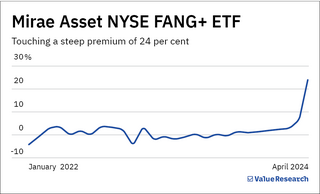
All roads to international stocks are currently blocked. Just a narrow alley remains.
The story so far
It's been a series of bad news for Indian investors seeking geographical diversification.
First, it was the mutual funds investing overseas that hit a dead end for crossing the regulatory limit of $7 billion on overseas investments in 2022. Later, the gates did re-open, when it went below the limit, but only slightly. Simply put, this option has become very erratic for investors of late.
Fast-forward to April 2024, it was the funds investing in overseas ETFs that met a similar fate, as it had crossed its separate limit of $1 billion.
Suggested read: SEBI halts AMCs from investing in overseas ETFs starting April 1
The squeeze on such funds was a big blow for investors, as they were often touted as the last route available to invest overseas. Sure, directly investing in international stocks through the liberalised remittance scheme (LRS) remains an option on the table, but it doesn't suit smaller investors. It is inconvenient and complicated.
So, the only gali left for investors is to explore the ETFs that are tracking international indices . These can be bought and sold on the Indian stock exchanges. However, given these ETFs' recent surge in demand and limited supply, they are being sold to investors at a significant premium.
What do we mean by that?
When we say that an ETF is trading at a premium, it simply means that the price you pay to buy the ETF on the stock exchange is higher than the total value of all the stocks it holds (net asset value).
Normally, the market price of an ETF is expected to be around its NAV, but deviations may occur due to the demand-supply gap.
That's not good news for investors looking to buy these ETFs, as they effectively pay more than the worth of the underlying assets.
What's happening currently?
While it is quite normal for ETFs to trade at a slight premium or discount, a vast majority of them are being sold at a higher price right now.
The problem is especially exaggerated among ETFs replicating international indices, as options to invest overseas are almost nil following the SEBI restrictions.
If you look at the table below, Mirae Asset NYSE FANG+ ETF and Mirae Asset S&P 500 Top 50 ETF are being sold for a 23.9 per cent and 15.2 per cent premium, respectively.
| Fund name | Premium |
|---|---|
| Mirae Asset NYSE FANG+ ETF | 23.9% |
| Mirae Asset S&P 500 Top 50 ETF | 15.2% |
| Motilal Oswal Nasdaq Q50 ETF | 5.2% |
| Mirae Asset Hang Seng TECH ETF | 5.1% |
| Nippon India ETF Hang Seng BeES | 4.7% |
| Motilal Oswal NASDAQ 100 ETF | 1.1% |
|
Note: Premium as of March 22, 2024. Source: nseindia.com, AMC's website |
|
As the charts below show, the duo's selling price dramatically spiked recently, coinciding with SEBI's restrictions on ETFs investing overseas.


What you should know
The returns mentioned on these ETFs factsheets will be quite different in reality. That's because fund houses calculate returns based on the ETF's NAV. But since you are paying a premium, your potential gain will be lower.
For instance, if you buy Mirae Asset NYSE FANG+ ETF at a 23.9 per cent premium, the investment will have to generate an additional 23.9 per cent to be on par with the return mentioned on a factsheet.
Of course, you can also sell the ETF at a premium, but whether you can do so in the future is not guaranteed.
This is why it's best to avoid the ETFs that are being sold at such a high premium.
Suggested read: Good time to invest in Mirae Asset NYSE Fang+ETF

Where to invest
If you must explore the ETF route, you may consider alternatives like the Motilal Oswal NASDAQ 100 ETF . This ETF is currently trading at a relatively lower premium of 1.1 per cent.
It can be a sound addition as it replicates the highly-vaunted US-based Nasdaq 100. For the uninitiated, FAANG stocks, a high-growth tech group comprising Meta (Facebook) , Apple , Amazon , Alphabet (Google) , Netflix , have a 30 per cent weight in the index.







